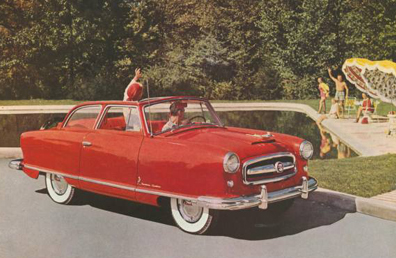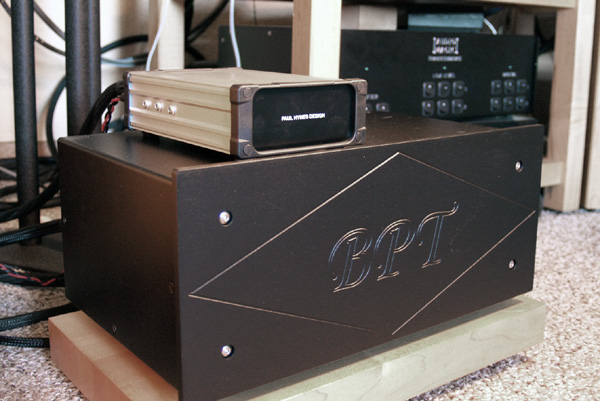|
You are reading the older HTML site Positive Feedback ISSUE 45september/october 2009
Audio Ramblings Part
Redux - Who should be feeding the Empirical Audio
Off-Ramp 3: Hynes or Hoff?
Ramblings' redux. Except this one is about what's been going in my computer audio journey, and… there is some interesting things a brewing here. Especially so with the Empirical Audio Off-Ramp 3—that has since replaced the Pace Car due to compatibility issues, not because it is better than the Pace Car, though it is mighty close as it is now configured… so read on. I recently had the Off-Ramp upgraded to the UltraClock ($800) from the standard SuperClock. This has really moved the Off-Ramp's performance several notches up the proverbial ladder of audio colloquialisms. Simply said, it is way better in every way than the standard Off-Ramp. Smoother, more 'analog-like', tonally richer, liquidity up the wazoo, and simply being more musically involving all come to mind. Not that the standard Off-Ramp wasn't getting one any of this sonically, it was—read my comments about it in an earlier issue, I loved it so much that I bought it for USB—but with the UltraClock, shit man, this thing is stellar. Worth the $800? I find that the UltraClock is equal to any cable or AC cord upgrade—which can, in the right place and right measure, transform a system. Yeah, that is the UltraClock. It really is quite nice and for me an easy upgrade cost to justify what I am hearing—all that the standard Off-Ramp could do, just now it is way, way better in every way! Sweet.
The Off-Ramps 3 sitting on a Shakti Stone. The brass weight keeps heavy cables from tipping the unit back off the shelf. Of course that makes one wonder then… huh, the Off-Ramp is powered by the wall-wart power supply. As good as a unit as it is (I am sure Steve at Empirical is sourcing the best one he can find), what would happen if one changed that out for something better? Something made just for us audio-nuts for that purpose? Mind you I am not thinking of just an off-the-shelf rechargeable battery supply or some generic regulated DC power supply, but something quite different. Now I will admit that I did have the Empirical battery unit to use with the Pace Car, but when I sold that it went too. Yeah, it did make either the Pace Car or the Off-Ramp sound better than when matted to the supplied wall-wart power supply, but I never really felt that it was really rocking things. Differences were subtle but evident… but nothing to rock the audio world. So what to do? Well it seems that one has a few choices in that Chris Hoff at Balanced Power Technologies (BPT http://www.b-p-t.com ) makes a purpose-built battery unit (the BPT) that is not something off-the-shelf. Open the box and yeah, there is the ubiquitous recharger and one large 12V 12Ah SLA battery, but then Chris routes the DC through various capacitors (a $50 option)—Chris refers to this as "multiple ultra low impedance electrolytic capacitor supply in parallel with polypropylene and polystyrene capacitor bypass after the battery". You can also get this upgraded with two V-Cap Teflon bypass capacitors (a $100 option). You can get the BPT with either 4N 12AWG OFC Litz wire or 6N UP-OCC 12 AWG stranded copper wire for all internal connects, and for external connections, 24"- 48" 12AWG 4N OFC Litz umbilical with shielding ($75 longer slightly higher) or 24"- 48" 12 AWG 6N UP-OCC umbilical with shielding ($100 longer slightly higher). The BPT comes standard with a high quality 18AWG shielded umbilical 24"- 48" long (longer lengths incur extra charge) and12 AWG 4N oxygen free copper high current internal wiring. Housed in a large-ish black metal cabinet (the same cabinet Chris uses for one power conditioner lines) with either silver or black face-plates, when fully optioned, the BPT is one serious battery power supply (the standard unit is $350, so do the math if you want the options). My comments are based on the fully-pimped-out BPT ($500) that Chris sent me—so buyer beware. Or if batteries ain't the way for you to go (after all the batteries will only give you so many hours of listening before they drift off into the distance—but with the BPT I do get a good 8-10 hours here) you could go the Paul Hynes route with one of his regulated SR3-12 DC power supplies (http://www.paulhynesdesign.com). Now these are well regarded by various Empirical users (let alone anyone in the audio realm in need of such a supply to supply DC to whatever) and are only available from Paul himself who resides in Scotland (prices vary due to the exchange rate, but plan on around $500 plus shipping). Nice stuff deed.
The Hynes SR3-12 sitting atop the BPT unit So what is the deal on either? Well both are quite stellar in all the right ways: clean, smooth, grain-free, spatial presentation, palpable presence, airy, dynamic, etc. That they are so much better than the supplied wall-wart supply; I could easily live with either. Going back to that is sort of having a Firestone ale and then going back to a Coors. Yeah, it's beer, it refreshes on a hot day, but it is clearly lacking character and taste. With either power source feeding the DC to the Off-Ramp, you get character and taste in your music. Not only do they refresh, but they do it with real taste! So each works wonders, but the $500 question is naturally, "Which is better?" Not to take the easy way out, but while they each have their strengths, neither really is a clear winner over the other—it is more a matter of preference and whatnot than this is clearly superior to that. I have had several people over and we all pretty much agreed as to what they are doing to the Off-Ramp's impact on the music, and naturally there were slight preferences for this over that and of course, vice versa. First off, we could hear no difference tonally in the music from the Off-Ramp 3 regardless which was powering the DC. So that was a toss-up. If there were any differences in this area it was too close to call. On the other hand there were 'other' differences in that… Music with the SR3-12 is a tad incisive and upfront whereas with the BPT it is a tad laid-back and relaxed. The SR3-12 gives a touch more slam and control to the bottom-end, where the BPT is a bit softer and looser. The SR3-12 has that vice-grip on the music whereas the BPT is a bit freer and looser… a softer touch. On the other hand music with the BPT has an organic airy quality when compared directly to that of the more controlled and defined SR3-12. The BPT also produces a larger and more 3D soundscape than that of the SR3-12, but differences are less than one should really care about. That is, these differences are all quite subtle and in the end any of the listeners could easily live quite happily with either supply feeding the Off-Ramp. It was more of a "If push came to shove, do you hear any difference when one is swapped for the other?" This was not a night and day thing… more of a mid-afternoon to late-afternoon thing. So don't go away from this thinking that one is clearly better than the other; in the end the magic was still happening—just that the 'overall' presentation was just ever so slightly shifted in one way or another. Interestingly enough, AC cords did make a difference and for the most part the differences I mentioned above became quite moot when either device was compared using the same cord—or mated with a non-complimentary cord (see below). Chris supplied a couple of his cords to audition and each is quite nice. Using his cords on either power supply revealed that the BPT L-9C power cord ($499 w/Oyaide plugs) to be a tad more upfront and dynamic than the ever so slightly laidback and softer BPT L-9CS power cord ($499 w/Iego plugs). Either is quite nice in that differences are again rather moot in the context of listening to music (they are smooth and quite musically resolving so in the end any perceptible differences really didn't matter all that much). Also in house is the Audience powerChord which features the latest "e" enhancements from Audience. Compared to the two BPT cords, the Audience powerChord was just that more engaging overall (a bit more dynamic and extended at either extreme along with a bit more excitable incisiveness), though differences are again a matter of preference and synergy. But even so, the Audience cord was better at revealing what differences we could ascertain between these two wonderful power sources. We all liked it quite a bit in this set-up. What was really interesting is that using the BPT L-9CS on the SR3-12 and the BPT L-9C on the BPT made any differences between the two power sources to now be such a close to call that, well… any differences were now too close to call. When push once again came to shove there was now no commitment or comment about any possible differences/preferences. Nice. Of course using any of these cords doubles the investment, but then as audiophiles we know the drill… everything seems to matter is some way, so the pursuit never really ends. Based on extended listening I could live with either power source: the BPT or the SR3-12. Each is a wonderful source for the Off-Ramp and I would conjecture any other device needing 12 volts DC. Yes, the BPT has slightly more of that wonderful sense of liquidity and space combined with its slightly smoother and relaxed presentation. And yes, the SR3-12 presents music in a slightly more upfront and dynamically involving way while possessing slightly more control and extension in the bottom-end. But in the end, the two supplies' presentations were really more reflective of how each supply develops its DC (no surprise there). The BPT sounded more like batteries and the SR3-12 sounded more like a regulated power supply—though ultimately they sounded more alike than different. Both are highly recommended but you will have to choose your poison. More to come on these wonderful two power supplies. Hynes http://www.paulhynesdesign.com
|



